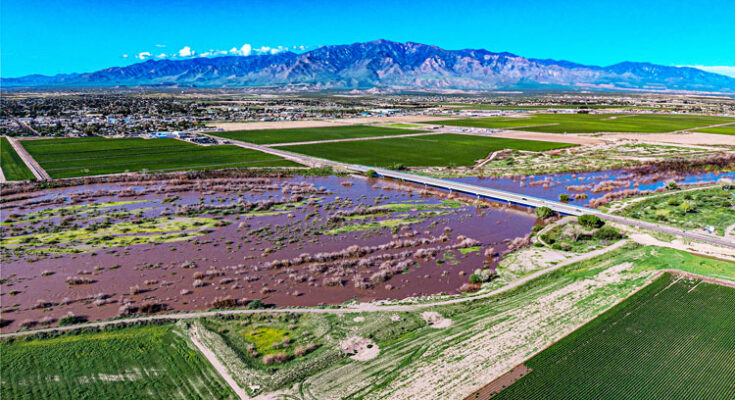Op-Ed By Rep. Gail Griffin
Arizona is often portrayed as a state on the brink of a water crisis. Yet few realize that more than 90 percent of Arizonans already live under some form of groundwater management.
From the early 1980s onward, the state has built one of the most comprehensive water-management systems in the nation—layer by layer, region by region—offering three core tools that embody Arizona’s groundwater framework without imposing a one-size-fits-all mandate.
These include Active Management Areas (AMAs), Irrigation Non-Expansion Areas (INAs), and Mandatory Adequacy jurisdictions, each providing unique protections based on the needs and facts of each area.
Active Management Areas Regulate All Industries
Created under the 1980 Groundwater Management Act, AMAs prohibit farmland expansion, regulate groundwater pumping, set long-term management goals such as “safe yield,” and implement ten-year management plans that impose increasingly stricter conservation standards on municipal and industrial water users and efficiency requirements for farmers.
AMAs also require each new residential subdivision to demonstrate a 100-year assured water supply before construction and to replenish every drop of groundwater used in perpetuity if required by the management goal.
The first five AMAs were established in 1980 and covered Phoenix, Pinal, Tucson, Prescott, and Santa Cruz, accounting for roughly 85 percent of Arizona’s population today.
Irrigation Non-Expansion Areas Halt Agriculture
Established in 1982, INAs prevent new land from being brought into agricultural production and require existing farmers to meter and report their annual use to the state’s water agency. The first three INAs—Joseph City, Harquahala Valley, and Douglas Basin—were created that same year, adding roughly one percent of Arizona’s population to water-managed areas.
Mandatory Adequacy Regulates Rural Housing
In 2007, the Legislature authorized cities, towns, and counties outside of AMAs to adopt the Mandatory Adequacy program, which requires housing developers to demonstrate a 100-year water supply before approving new residential subdivisions.
Yuma County adopted it in 2008, followed by Cochise County and the towns of Clarkdale and Patagonia. Although Mohave, La Paz, and Coconino counties were the most vocal advocates for the authority in 2006, they never adopted the program. That year, Representative Trish Groe said these counties were “begging for the 100-year adequacy requirement,” but no action was ever taken.
Yuma and Cochise counties account for about 4–5 percent of Arizona’s population.
Other Areas Are Also Managed
Court decrees and water rights settlements in general stream adjudications set parameters around the use of surface water in other areas across the state.
Farmers in Graham and Greenlee counties, for example, cannot use more than six acre-feet per acre per year, setting caps on the amount of water that can be pulled from the Gila River. These two areas add another half percent to the total.
Taken together, over 90 percent of Arizonans live under some form of water management: inside an AMA, an INA, within a county or city that has voluntarily adopted the Mandatory Adequacy requirement, or some combination of these. Douglas is the only place in the state that has been subject to all three.
This patchwork isn’t a weakness—it’s a strength that allows solutions to match local realities.
Arizona Has Every Tool It Needs
Some have called for creating new management tools or sweeping state frameworks. With the Groundwater Management Act of 1980 and its companion laws, Arizona already has every tool it needs to protect local supplies where science and residents support it.
Even Governor Katie Hobbs has acknowledged this, saying at the University of Arizona’s 2025 Water Resources Research Center Conference that: “We have the tools to protect groundwater throughout this state.”
Improving our existing tools to make them more workable should be a goal.
In 2025, the Legislature passed several bills to improve the existing tools—including bills to improve agricultural efficiency and local control in AMAs, set annual pumping caps in INAs, and increase flexibility in the Mandatory Adequacy program—but Governor Hobbs vetoed all of them, leaving Arizona’s framework exactly as it stands today.
Arizonans Must Utilize Existing Tools
If residents want stronger groundwater management, they can petition the Department of Water Resources to form an AMA or INA. If they want to manage growth, they can ask their county supervisors to adopt the Mandatory Adequacy program. These choices can and should be made locally, based on hydrological facts and community consensus.
In 2022, Douglas Basin residents voted to convert their INA to a full AMA. That same year, Kingman residents petitioned the Department for an INA in Hualapai Valley. In 2024, Governor Hobbs established an AMA in the Willcox Basin, although a majority of voters had opposed creating an AMA in 2022.
Each of these actions demonstrates that the tools already in place remain active, viable, and responsive to local needs, proving that Arizonans already have all the tools they need to protect their water futures.
Let’s Focus on Improving Populated Areas
In Arizona, water is managed where it matters most—in the areas where the majority of residents live.
With more than 90 percent of Arizonans already covered by existing groundwater frameworks, our focus should be on improving the tools we already have in the areas where the most people live.
Gail Griffin is a Republican member of the Arizona House of Representatives serving Legislative District 19, which includes areas of Greenlee, Graham, Cochise, and eastern Pima and Santa Cruz Counties. She also serves as Chairman of the House Natural Resources, Energy & Water Committee.











